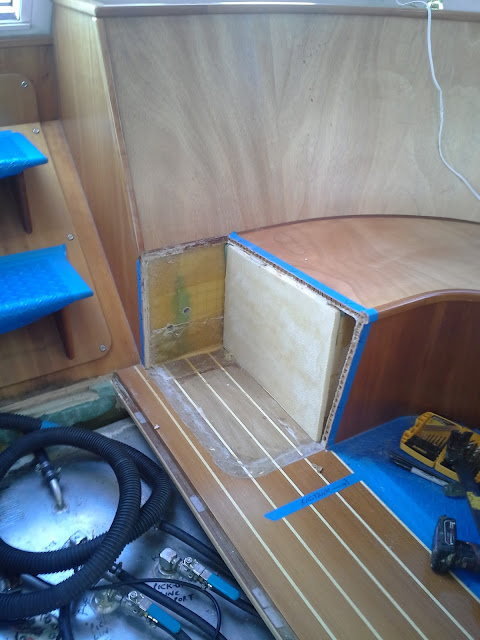Since Stuart Yacht Harbour had to work us into their schedule for the fuel tank repair, we decided to leave the boat with them and go home until the repairs were completed. We rented a car and drove home in two days to Gloucester, VA. We came home to snow, ice, and cold weather, exactly what we were trying to escape by cruising to Florida for the winter. However, the sunsets we get over the York River in our back yard almost made it worth chipping ice off of the front stairs for three days.
Gregg Burdick at Stuart Yacht kept me updated via email and pictures on the progress they were making on the fuel leak repair. The first photo sequence shows cutting out the floor and seats on each side to expose the tank.
Once the tank was exposed and disconnected they lifted it up to remove it from the boat for testing. You can see the fuel soaked foam blocks under the tank in this photo.
The next sequence shows the tank being set back into the boat, and all of the fuel lines being reconnected. Then before testing the lines the area under the tank and voids all around the edges were filled with closed cell foam. If any fuel should leak during the coming tests it would not be able to get back underneath the tank and could be easily cleaned up. This also had the effect of sealing the exterior of the tank on all sides except the top so that if any leak should develop in the future fuel would not be able to leak out of the tank.
After foaming the tank into the boat, all of the lines were reconnected and tested. The lines on this tank are fuel and return lines for two engines, a fuel polishing system line, and two transfer lines for transferring fuel between the forward tank and the aft tank (the one being tested). Fuel was transferred back and forth between the forward and aft tank repeatedly, the engines were run for an hour, and the fuel polishing system was run long enough to polish all of the fuel in the tank. No leaks were detected.
By that time, it was Friday evening and the crew locked the boat and went home for the weekend. When they returned Monday morning it was discovered that there was a very small amount of fuel on the top of the tank around the fuel gauge sending unit. It was also found that the valves for the fuel transfer lines on the forward and aft tanks had been left open over the weekend.
After all of the testing that had been done, the working theory became that when the tank was full, and a transfer valve was left open, that fuel draining back into the tank caused pressure on the tank and since the sending unit had demonstrated a small leak during the freon test, that small amounts of fuel were leaking from there over a long period of time. Eventually, the small repeated fuel leaks saturated the foam blocks under the tank and then the leaked fuel began finding its way out of the tank compartment and into the port bilge, which is where I first noticed it. A new fuel gauge, sending unit, and gasket were ordered and installed, and the closing in of the tank compartment began. The previous owner and I had both been in the practice of leaving the aft transfer valves open after transferring fuel and closing only the forward valves. I have instituted a new protocol that both sets of valves will be left closed unless I am actually transferring fuel.
The next photo sequence shows the carpentry work stages to reassemble the floor and seats. When we came back to the boat I placed oil absorbent around all of the penetrations on the top of the tank and will check them daily as we cruise to make sure that nothing is leaking
The completed carpentry work is practically invisible! Unless you were very familiar with this particular model of boat, nothing about the repairs would catch your eye. We are very pleased with the result!
Below is "Building Our Wings" lying at Stuart Yacht's dock after repairs were completed. Another PDQ MV-34, "Miss My Money", is just behind us at the dock and had pulled in the day before we were ready to leave for some repairs needed on his boat. We'll be out of here soon!





















No comments :
Post a Comment